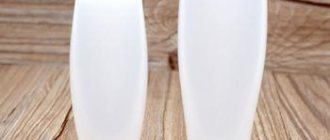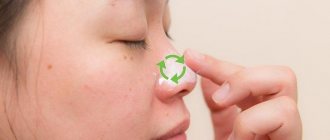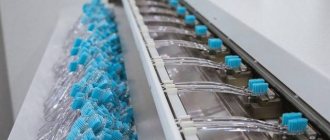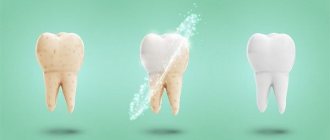- Types of toothpastes
- Properties of toothpastes
- Composition of toothpastes
- Choosing toothpaste according to problem
How many of us buy toothpaste? They make a shopping list and go to the hypermarket. If this sounds like you, then most likely you underestimate the role of toothpaste in your health. A good toothpaste protects against caries, ensures that teeth do not lose minerals, and most importantly, does not harm the enamel. In this article, we will analyze in detail the compositions of modern pastes and tell you how to choose the one that really suits you.
Tip No. 1: calculate harmful components
Only a few of us have received medical education and have an idea of what is “mixed” into our daily oral and body care products. This applies not only to toothpastes, but also to the entire arsenal of drugs (shampoos, creams, etc.). But you always need to strive for perfection, and if you don’t at least know thoroughly all the nuances of production, then have an idea about them.
The content of harmful substances should be kept to a minimum
A good toothpaste should effectively remove food debris and fight various types of bacteria. It is also good if it helps to normalize the balance of microflora in the oral cavity, strengthen enamel, create conditions for the prevention of caries and gum disease, get rid of unpleasant odors and give fresh breath.
To provide all these positive properties, manufacturers add various active ingredients to the composition. But they must be as safe as possible, natural, and contain a minimum of harmful substances:
- lauryl sulfate and propylene glycol (PEG): components are almost irreplaceable in any hygiene product, as they contribute to the formation of thick foam and the destruction of dirt. But in large dosages they cause allergies, manifested by unbearable itching. They can also provoke inflammation of the gums and periodontal tissues (periodontitis and periodontal disease). In addition, the substances are extremely toxic, dry out the mucous membranes, and are hazardous to health,
Periodontitis and periodontal disease - parabens: the best toothpaste should not be stored for more than 12 months from the date of production (and this is the maximum). Otherwise, it contains a lot of parabens. These substances increase its shelf life, but are not excreted, but accumulate in the body and even provoke the development of cancerous tumors,
- triclosan, metronidazole: these are antibiotics and their use is justified only in the presence of acute inflammatory processes in the mouth. However, such components are often included in regular pastes and therefore many do not even suspect that their use should only be carried out under the strict supervision of the attending physician. As a last resort, you can use pastes in courses, no longer than one month in a row. Otherwise, you risk getting complications in your internal organs. For example, on the lungs, kidneys, liver. And there is also a risk of “exterminating” not only all harmful, but also beneficial microflora in the mouth.
On a note!
Sodium lauryl sulfate, for example, contains most of the well-known and advertised pastes, such as Blend-a-med, Colgate, Oral-B, Forest Balsam, New Pearl.
Toothpastes - how to choose the right one
A good oral care product should not only be effective, but also be as safe as possible. Some manufacturers saturate their products with components, a high concentration of which can cause serious harm to human health in general.
Products based on plant components do not contain harsh chemicals and provide gentle cleansing. Essential oils and extracts of medicinal plants must be supplemented with surfactants (surfactants) - without them, high-quality cleansing is impossible. It’s another matter if the surfactants themselves are of a plant nature, and then we can confidently call the product completely natural. This is a good choice for children as well as adults!
Criterias of choice:
- A type of pasta.
As mentioned above, you need to choose a product based on individual needs and indications. If there are no problems with your teeth and gums, a prophylactic paste would be the best option. If there are problems with the enamel or the condition of the mucous membrane, it is worth considering treatment and preventive options. But in this case, you must first consult a dentist.
- Ingredients included.
Be sure to read the ingredients carefully before purchasing. If there are allergy sufferers in the family, it is important to make sure that there are no components that can provoke allergic reactions.
- Degree of abrasiveness
The presence of abrasive particles ensures high-quality mechanical cleaning of plaque and allows you to return your teeth to their natural whiteness. On the other hand, too long exposure of this kind leads to injury to the enamel, its thinning and hyperesthesia.
- Taste and smell
As for taste and smell, these criteria are left to the discretion of the user. Sometimes a too strong taste can cause unpleasant sensations or even gag reflexes - this also needs to be taken into account.
Adult toothpastes
Such toothpastes have the ability to eliminate pathogenic bacteria and freshen breath. Prevents the appearance of plaque and tartar.
✅Toothpaste “Comprehensive care” LAVERA
The toothpaste contains organic echinacea and calcium, which have an anti-inflammatory effect on the gums and improve the health of the oral cavity.
The highly effective fluoride-free formula is rich in natural minerals, gently cleanses, protects the oral cavity from bacteria and freshens breath! With regular use, it prevents the appearance of tartar. Suitable for children. Does not contain fluorine and microplastics.
The German brand Lavera is the first in Germany among organic cosmetics! And the Germans, as you know, know a lot about the quality of natural products!
The naturalness and safety of the product is confirmed by the international standard NATRUE.
✅Refreshing toothpaste “Mint” COSLYS
Toothpaste, thanks to its 100% natural formula with calcium carbonate and aloe vera, gently cleanses teeth and prevents plaque.
Stevia extract, menthol and mint essential oil provide a pleasant, refreshing taste. Does not contain fluorine, titanium dioxide and synthetic dyes.
The French brand Coslys not only produces natural cosmetics, but also cares about reducing its eco-footprint.
The naturalness and safety of the product is confirmed by the international standard COSMOS ORGANIC.
Unflavored toothpastes
Such pastes are suitable for pregnant women, people with various taste intolerances and for homeopathic treatment. They do not contain mint and do not cause nausea.
✅Organic toothpaste for pregnant women (for allergy sufferers) AZETA BIO
The toothpaste was created specifically for pregnant women and people with various taste intolerances. Its delicate, special taste does not cause nausea.
Thanks to its special formula with aloe and xylitol, it perfectly protects and cares for tooth enamel and gums. And Barbados aloe extract provides a mild soothing and antibacterial effect.
Clinical studies confirm that regular use of toothpaste reduces the formation of plaque and the number of microorganisms that cause caries. The naturalness and safety of the product is confirmed by the international standard AIAB bio eco cosmesi.
✅Toothpaste “Zero Balance” SPLAT
Hypoallergenic toothpaste is odorless and has a subtle sweet taste. Great for protecting against tooth decay and keeping your breath fresh.
Active components: silver in active form (a powerful antibacterial component and antiseptic), potassium glycyrrhizinate (an active component of licorice root, which has anti-inflammatory and antibacterial effects), perilla seed extract (suppresses the growth of cariogenic microorganisms, preventing the formation of caries).
Clinically proven effectiveness after 4 weeks of use:
36.3% anti-caries effect - 36.3%, cleansing effect - 63.6%, anti-inflammatory effect - 37.5%.
Children's toothpastes
Children's teeth are especially susceptible to tooth decay because tooth enamel is not yet as strong as that of adults. In addition, caries of primary teeth has a direct impact on molars.
Children's toothpaste should not contain fluoride and its derivatives! According to statistics, about 30% of toothpaste is swallowed by young children while brushing their teeth, so children's oral care products should be as safe as possible.
Children are allowed to use adult toothpastes from the age of 14; until this time, parents must buy special children's products.
You can read more about caring for baby teeth in the article “TEETH CARE FROM CHILDHOOD - DENTIST’S ADVICE.”
The requirements for this category of pastes are special. This is exactly the case when you cannot trust only one package. The components in the composition must be gentle.
Foaming agents in children's toothpastes should be contained in minimal quantities or completely absent. Flavoring and aromatic additives should be natural ingredients.
✅Children's toothpaste “Strawberry-Cherry” SPLAT
The toothpaste is intended for children from 2 to 6 years old. The innovative LUCTATOL® system based on licorice extract and lactic enzymes destroys cariogenic bacteria and blocks their further development.
The effectiveness has been clinically proven: cleansing effect - 41.7%, remineralizing effect - 34%, anti-inflammatory effect - 48.4%.
Intensive strengthening of enamel is ensured by calcium hydroxyapatite (nHap).
Active ingredients: grape seed extract (effective in combating the cariogenic bacterium Streptococcus mutans), L-Arginine (helps strengthen enamel), Aloe Vera gel (has an anti-inflammatory effect)
✅Organic toothpaste with xylitol “Raspberry” AZETA BIO
The toothpaste is suitable for children from 3 to 7 years old. Specially designed for gentle care of delicate gums and tooth enamel. The natural remedy prevents the development of osteoporosis because it helps increase bone density.
Xylitol promotes calcium absorption and improves enamel mineralization. The substance stimulates saliva production and reduces plaque deposits.
Aloe juice extract has an anti-inflammatory, astringent effect, soothes irritated gums and aphthae.
Sorbitol has an anti-caries effect, which is associated with a decrease in the production of organic acids in the enamel.
Environmentally friendly composition and packaging made from renewable and recycled materials.
The naturalness and safety of the product is confirmed by the international standard AIAB bio eco cosmesi.
Tip #2: pay attention to abrasives
Everyone knows that without abrasives, an adult paste will simply be inferior, because then it will not be able to cope with the plaque that forms on our teeth every day. By the way, on packages this indicator is usually indicated by the abbreviation RDA.
Please also note that the abrasives in toothpastes are different:
- calcium carbonate: the most common. These are quite large particles, they roughly remove plaque, but in no way have a remineralizing and restorative effect on the enamel,
- Aluminum oxide: the drug is prohibited in the European Union and the USA due to its harmfulness. It often leads to the formation of inflammation and ulcers in the mouth due to its aggressive component. It has also been proven that high levels of this substance in the body enhance skeletal abnormalities, disrupt the metabolism of phosphorus and calcium, slow down metabolism, cause osteoporosis of the bone structure,
- silicon oxide: the most preferred composition, it is finely dispersed and does not have a negative effect on the enamel.
Children should use children's toothpaste.
Another tip: never use the same toothpaste for all family members. It is not suitable for children, because the adult composition can be harmful to children’s fragile enamel; people with sensitive teeth should also be careful. The permissible number of abrasives for children is 20-30 RDA. For adults with healthy teeth - up to 100 RDA, for sensitive enamel - no more than 60. For smokers and those who want to whiten their shade - 120-150 RDA. The same paste cannot provide the same effect to everyone.
Taking into account the markings
Not so long ago, one could find information on the Internet that the markings on toothpaste tubes, made in the form of colored stripes on the “tail” of the tube, have informational value. There were versions that this was either a designation of the degree of abrasiveness, or marks indicating the percentage of natural or chemical components in the posts, or a designation of which class the product belongs to.
However, according to GOST and ISO, the colored stripes on the tube do not carry any information for the consumer - they are not registered there.
“Marking” tubes of paste is just a technical point in the manufacturing process: in order for all the images to be correctly applied to the tube, such stripes are drawn on it. At the same time, it is important that the strip has maximum contrast - after all, the process is automated, and it will be read by a special sensor.
Tip #3: Fluoride is not always beneficial
Some people mistakenly believe that which toothpaste is better can be determined by the high fluoride content in its composition. Indeed, the element is extremely important, since without it, proper calcium metabolism in the body is simply impossible. In addition, it helps strengthen the enamel, and recent studies have proven that the component reduces the risk of developing caries by 30-40%.
However, fluorine is toxic and is completely unsuitable for those who live in regions where the water and soil are saturated with it - the Moscow region, Nizhny Novgorod, Sverdlovsk, Tver, Tomsk regions. The microelement, or rather its excess, can provoke various diseases and cause extremely unattractive fluorosis on the teeth.
The photo shows dental fluorosis
As for the concentration, it should not exceed 1500 ppm in pastes for adults, and 500 for school-age children. For children under 5-6 years old, it is better to exclude this component altogether, because it is quite toxic if swallowed.
What is better to choose to restore gums?
Brushing teeth with damaged gums is necessary only with a properly selected product. Factors that provoke damage to the mucous membrane:
- Mechanical.
- Bacterial.
- Hereditary.
Damaged tissues may begin to bleed, become inflamed, and hypersensitivity often occurs. Pastes should have an antibacterial and healing effect. Some products also perform the function of preventing the formation of tartar. Below we look at the best options:
- Forest balm.
- Parodontol Active.
- ROX Bionics.
- Splat "Lavandasept".
- President Exclusive.
Tip #4: use the paste according to the situation
It is quite difficult to answer unequivocally the question of which toothpaste is best to use. After all, everyone is looking for exactly what suits them. For example, one person needs to whiten enamel at a given time. For gentle whitening, there are worthy representatives with a high content of abrasive substances that will effectively solve the problem of yellow enamel even in smokers. Among the leaders approved by experts were Colgate and Silca, which really give a brightening effect.
For each problem, select the appropriate paste
However, their composition is completely unsuitable for people with hypersensitive teeth who need to strengthen the enamel. The drug will also harm those who are trying to stop the development of gingivitis and get rid of bleeding gums.
If you are trying to whiten your teeth at home using toothpastes, then remember: no home whitening will be as effective as a procedure in the dental chair. As for safety, keep in mind that hydrogen peroxide and abrasives (both in pastes and in natural products: coal, soda, salt, lemon) in excessive quantities have a traumatic effect on the enamel, as a result of which it becomes thinner and becomes sensitive to temperature changes , to attack by bacteria. And enamel that has undergone such whitening requires remineralizing procedures.
Different pastes are suitable for different purposes. But remember that you cannot become attached to any one brand for a long time, even if it is the best toothpaste for you: change it once every three months so as not to become addictive. As for whitening and medicinal pastes, try to use them only after consultation with your dentist and for no longer than three weeks in a row.
Natural Teeth Cleaning Products
There is not a single toothpaste on the shelves of stores and pharmacies that can be called completely safe. Only 10% of products fully correspond to the term “environmentally friendly product”, although they also contain preservatives that ensure a long shelf life. How to get out of this situation without harming your health?
This is important to know!
Natural teeth cleaning products are not inferior to commercial toothpastes in terms of effectiveness, but they need to be prepared quite often. By mixing the necessary substances, each person is able to obtain the required composition and consistency for a wide variety of types of teeth and gums.
In folk medicine, the most popular ingredients are:
- tea tree oil – relieves superficial caries and inflammation of soft tissues;
- thyme - plays the role of a bactericidal agent;
- sage – stops bleeding in the gums and strengthens blood vessels;
- rosemary – improves blood circulation in the tissues that nourish the tooth;
- clove – good for toothache relief;
- peppermint – eliminates bad breath;
- chamomile is an excellent antiseptic;
- honey – contains essential vitamins, micro- and macroelements;
- baking soda - whitens enamel.
How to make your own toothpaste?
Homemade toothpaste recipes are quite varied and not complicated, although certain proportions must be observed. Some substances are also effective when used alone, such as citric acid or salt.
You can rinse your mouth with such simple solutions during the day, and in the mornings and evenings perform hygiene procedures with multi-ingredient toothpastes.
Sage with chamomile
- Mix white clay (70 g) with water to a paste consistency.
- Dissolve 10 drops of propolis in the mixture.
- Add 1 tsp. honey and 2 drops each of sage and chamomile oils.
- Brush your teeth twice a day.
- The paste removes food plaque and gum inflammation.
Tea tree, coconut and mint
- Mix half a teaspoon each of cinnamon, fennel and sea salt.
- Add 2 teaspoons of baking soda and 6 drops each of tea tree and mint oil.
- Mix thoroughly and add 1 teaspoon of coconut oil before each use.
- Store the paste in an airtight container.
- The product has a whitening and anti-inflammatory effect.
- It should be used no more than once a week due to the presence of soda in the composition.
Herbal powder
- Mix the powders of cinquefoil erecta, calamus and birch bark in a ratio of 2:2:1.
- Dilute in warm water until a cream consistency is obtained.
- The resulting paste nourishes and heals the gums, strengthens and whitens the enamel.
- After use, do not eat for 1 hour.
Wood ash
- Collect wood ash in a saucer.
- Dip the brush and brush your teeth with it.
- Potassium hydroxide, which is part of the ash, has a good bleaching effect.
- You can also mix it with store-bought paste.
Eggplant
- Cut the eggplant into circles.
- Bake in the oven until charred.
- Grind and mix with sea salt in a 2:1 ratio.
- The powder serves as a means to strengthen the gums.
Tip #5: shop at the pharmacy
No one is safe from buying a fake, but the risk of getting a low-quality product increases significantly if you do it in markets or in underground passages, or purchase goods from distributors.
It is better to buy toothpaste at a pharmacy
It is better to contact pharmacy chains, because they employ pharmacists and pharmacists who are directly responsible for the quality of the received product, its certification, expiration dates and storage conditions.
In relation to this point, it would be fair to mention which toothpaste is the best. This is the one that has the original composition declared by the real manufacturer, and complies with GOSTs and general technical conditions: 7983-99 and 29188.0. For example, like some of the drugs presented in the table below1.
| Index | Quality rating "excellent" | Quality rating "good" | Quality rating "satisfactory" |
| Color, aroma, consistency | Sensodyne, Splat, Lacalut sensitive for sensitive teeth and gums. | All pastes are Lacalut, Durodont 5, Dent & Healsh, Biocon. | Products from the brands “Forest Balsam”, “New Pearl”, “Ftorodent”. |
| Acidity of the composition and its effect on teeth | Sensodyne, Splat, Biotene, Durodont 5, Dent & Health, Biocon. | Lacalut, Forest Balsam, Pearl, New Pearl. | "Lesnaya", "Ftorodent". |
Moreover, price is not at all an indicator of quality; a product may turn out to be good and at the same time cost mere trifles, or it may be expensive and not at all correspond to the declared characteristics.
Pastes for sensitive teeth
The best toothpaste for sensitive teeth
What kind of toothpaste should you use for sensitive teeth?
The rating is presented below:
- Sensodyne F is a popular paste that contains potassium chloride. With regular use, pain disappears, the dentinal tubules are covered with a special protective layer, and the effect of irritants is reduced.
- MEXIDOldent - effectively affects tooth enamel; after regular use, the top layer is strengthened, pain completely disappears. The surface is not scratched. It is not recommended to use it for more than one and a half months.
- Oral-B Original - contains components that help strengthen dentin, the top layer of teeth. The sensitivity of dental tissue decreases after regular brushing.
- Colgate – contains sodium fluoride, potassium nitrate. Many dentists prefer this paste.
Teeth are strengthened not only by toothpaste, but also by proper nutrition.
To assess the condition of the oral cavity, it is necessary to periodically visit the dentist. If necessary, the doctor will give all the recommendations and teach you how to properly care for your teeth and mouth in general.
Tip No. 6: “homemade” formulations are quite suitable for the prevention of diseases of teeth and gums
According to statistics, consumer choice is influenced by the smell, color, packaging and taste of the product, but not by its quality characteristics. At the same time, no more than 10% of the formulations sold in stores can truly boast of the status of “environmentally friendly and healthy product.” Take, for example, the fact that preservatives are no longer necessary to store them.
Even toothpastes “rich” in minerals and natural plant extracts, which are quite good and tested by consumers, contain harmful substances to one degree or another. For example, Lacalut, Splat, President, ROCS. Therefore, some rightly believe that the best toothpaste is the one you make yourself.
Homemade toothpaste should always be fresh
For home care of teeth and gums, sage, chamomile, mint, tea tree oil, honey, and birch bark are suitable. According to reviews, users use them to cleanse the oral cavity in different compositions and concentrations; which toothpastes are better, everyone here determines for himself.
However, it is worth remembering one rule: good “homemade” toothpaste should always be fresh, and it should be prepared daily. Otherwise, you may not only not be beneficial, but also harm the body. And it’s not a fact that without adding abrasive particles you will be able to get rid of plaque.
According to the portal’s editors, this advice should not be abused. And homemade formulations are best used not as an independent element of care, but in combination with other daily hygiene products: toothpaste selected based on the condition of your teeth and gums together with the dentist, mouth rinse, irrigator and floss, and a properly selected toothbrush.
If you are still thinking about which toothpaste is best, then immediately go to see a dentist, he will examine your oral cavity and will definitely help you with advice.
Notice
: Undefined variable: post_id in
/home/c/ch75405/public_html/wp-content/themes/UltraSmile/single-item.php
on line
45 Notice
: Undefined variable: full in
/home/c/ch75405/public_html/wp-content /themes/UltraSmile/single-item.php
on line
46
Rate this article:
( 4 ratings, average: 5.00 out of 5)
prevention
- According to independent studies.
The best pastes, according to dentists
There is also a better toothpaste, according to dentists, the rating is presented below.
Lakalut
It ranks first in the ranking. The paste is antibacterial and can be used for both prevention and treatment purposes. Contains lactic acid, which allows you to achieve an anti-inflammatory effect.
Splat Lavandasept
In the control purchase category, the pasta took first place. Most dentists believe that it is beneficial for the gums, especially if they are sensitive, and has anti-inflammatory and antibacterial effects.
Effective toothpaste
Despite the fact that the composition contains whitening components, their effect is gentle, thanks to this it is possible to maintain the integrity of the dental coating. The cost of the product is high, but the result lives up to expectations.
Rocks
It ranks second in the top quality brands, the results were confirmed by a test purchase. It contains ingredients of natural origin, so the paste is the safest and many people prefer it.
The products manufactured by this company are of high quality. Vitamin E is also present in the composition; it preserves the integrity of tooth enamel.
Apadent
Paste recommended by many dentists
The best toothpaste with a healing effect. Containing nano-hydraxyapatite, the substance strengthens tooth enamel and prevents its destruction.
Numerous studies confirm the fact that in addition to its therapeutic effect, the paste has a filling effect and relieves the inflammatory process. Recommended for use in case of periodontal disease.
Experts advise
When choosing a toothpaste, some questions arise. Here are the answers dentists give to them:
Is whitening toothpaste safe?
Only cheap toothpastes that are saturated with abrasive substances that scratch and thin the enamel are harmful to teeth. The level of abrasiveness of the paste is indicated by RDA symbols and an index, which indicates the size of the abrasive particles. The optimal indicator is RDA 70–120 (LACALUT White, PRESIDENT White, SILCA Arctic White, SPLAT whitening Plus).
Are pastes with antiseptics harmless?
If pastes containing triclosan, chlorhexidine or hexitidine are used continuously, they can be harmful because Following the pathogenic bacteria, they will begin to destroy beneficial microflora. The course of treatment with such pastes should not exceed two weeks.
Is it true that gel is better than paste?
Both types provide equivalent care and cleansing. This is a matter of taste, and nothing more.
Should you brush your teeth after every meal?
The optimal mode for brushing your teeth is morning and evening. More frequent procedures lead to thinning of the enamel and increased sensitivity. For oral health, it is enough to brush your teeth for 1.5 minutes twice a day.











